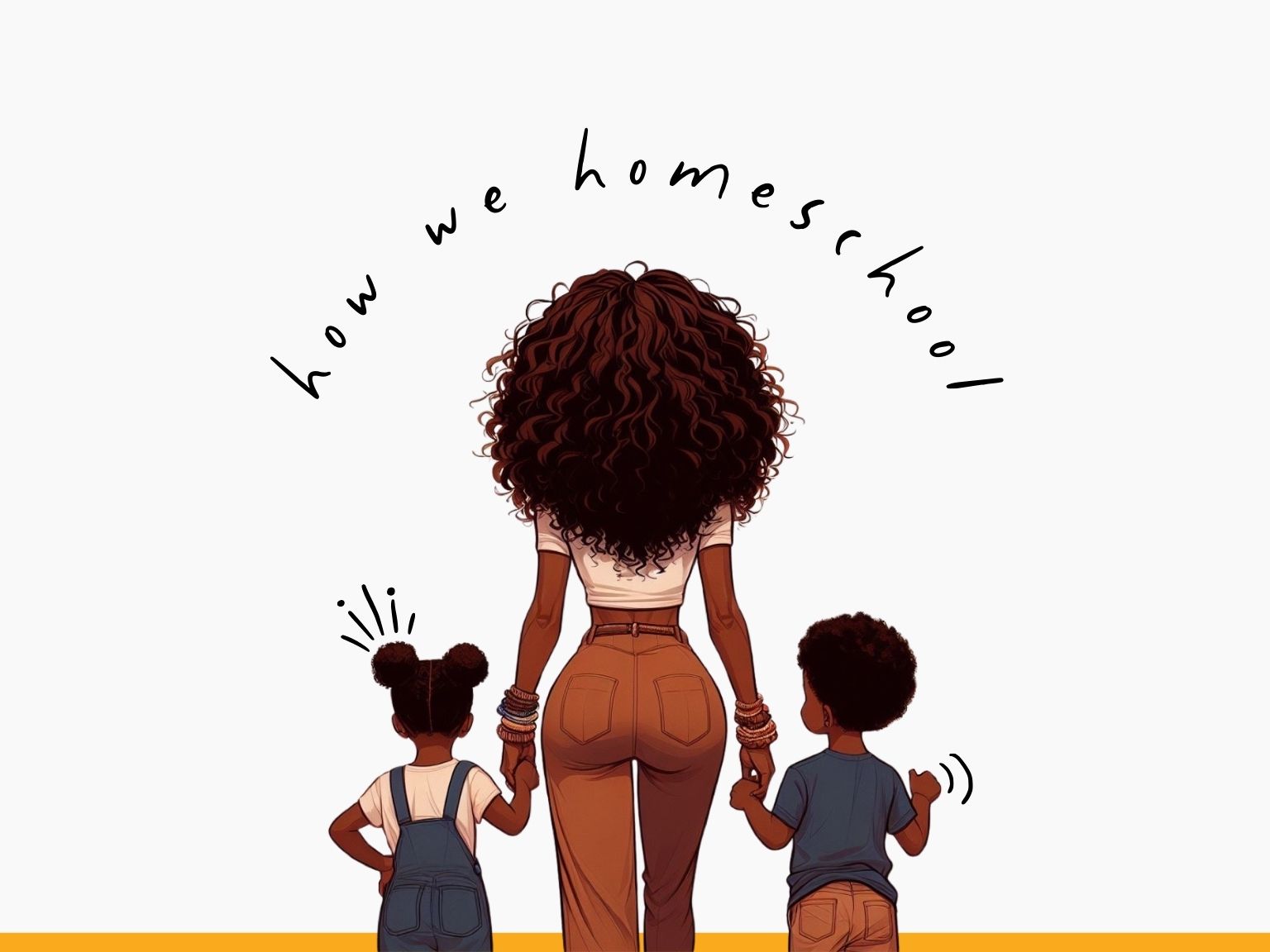we are officially a homeschool family now!
Technically this is our first full academic year of homeschool. Truly, this is the first time we have submitted paperwork to the state regarding our child’s education.
We are a Montessori family so I started instruction with my eldest when she was three years old. I could not find an accredited Montessori school anywhere near where we currently live and so began guiding my daughter from home. From there we hoped to find a public, private, or charter school that we all liked for but that never happened. When we were not agreeing on anyplace for Kindergarten either, we started seriously discussing homeschool through elementary.
My firstborn, Bug, has just turned five so we are starting Kindergarten! Her baby brother would not have us excluding him and so Chunk (who is nearly three years old) is in TK.
In a former life I taught preschool, and eventually Kindergarten for a number of years at a private school. My degree is also in Child and Family Development (#GoAztecs).
our planned approach to homeschool
Outside of not finding an institution everybody agreed on, there were a few other reasons we settled on homeschool for our family.
- I have been home with our children since my daughter was born. The transition would be far less dramatic for everyone.
- The side of the island we live on just happens to be really great for our homeschool style. It’s got a solid sense of community, environment, weather, and resources nearby.
- Individualized lessons and allowing each child to excel at their own pace. No worrying about our child being left behind, or bored waiting on the rest of their class.
- Flexibility in the schedule that we need while dad is active duty in the military.
- Easier to further emphasize life skills and how they relate to academics. (Like why we need to understand fractions, be able to read cursive, or develop cooking skills.)
- Siblings will be able to support and work off of each other as they learn and grow.
Related Post: Back to School Traditions
Because we have so many Montessori materials that seem to be working, we will continue to using them where applicable. Additionally, the Montessori method of observation of the child first will continue to be an integral part of how I lesson plan. We will discuss our schedule and structure of the calendar a little below but each session will have an overarching subject. (So far my favorites have been: Chickens & Cheese, Airplanes, and Anatomy.) I wouldn’t say we will be continuing a Montessori style homeschool but the environment will still very much be Montessori.
structure of our homeschool day (and year)
Currently, we are in school for three-week sessions, and then take a one week break. Three weeks on – one week off. In that week break we laze about, take more family time, schedule appointments, and reset for the next session. We are in school five days per week.
We tried this out for the tail end of the 2024 academic year and found it worked well for us.
As much as my little one protest the break periods, I think they work well. I decided to plan things this way for several reasons:
- One week off is just enough time to feel rested, but not feel like we need to thoroughly review information.
- Three weeks is a good healthy session time to cover one topic without tiring of it.
- We can get fully immersed in our unit and if there is some other lesson plan branching off from that, I can take the next week to gather resources and prep for the new lessons.
- I prefer year-round schooling.
- We can plan pretty evenly around holidays, birthdays, and vacations this way.
If you want a closer look into how we schedule out the school year, leave me a comment with your question(s). I can always create a post about it and give more details.
Our homeschool is loosely planned out by the month. I try to include the core subjects and enrichment below, as well as a few outings. Every month I would like to take the kids out to lunch someplace local that relates to our unit. Because they are still young I want to take this time to get them accustomed to dining out, since we haven’t done much of that with them. We also subscribed to memberships to the aquatic park and zoo in our area, and attend classes at some of the botanical gardens. We visit our library about every three days and rotate between a few close-by. I try for one unit-specific field trip every month if I can swing it as well.
core subjects and supplemental enrichment topics (curriculum)
Since Chunk is just preparing to start school he will be focusing on letters and numbers right now. He has a good grasp on pronunciation of about half of the letter sounds, knows all of his letters, is able to count pretty well, and knows must of his numbers. We discuss the concept of time a teensy bit, just because he has been very interested in clocks of late. Chunk’s working on pencil grasp and strengthening those muscles because he wants to do what he sees his sister doing. It’s great to see him applying himself but I don’t require him to practice his handwriting at all just yet.
These were about the same for Bug at this age. Now she knows all of her letters, letter sounds, and numbers. The bigger focus is writing them each out. Outside of that the subjects she will be taking this academic year are:
- English and Language Arts
- Mathematics (including time and money)
- Life Sciences
- Black History
- World History
- Arts & Culture
- Geography
Her enrichment subjects include things like Cross-Stitch, Gardening, Self Awareness, and Healthy Relationships this academic year.
how i have laid out the lessons
Bug and Chunk do the majority of their academic time side by side. At times I do need to sit and focus with one child. During these instances, the other child gets started on a variation of what we’re doing independently. Once both kids are up and running I just go back and forth checking in along the way.
We do not tackle every subject every day. Or even every other day. Right now I plan out our lesson plan the week before, and schedule lessons around other appointments. On days that we have an outing planned we have far less instruction or possibly even none at all. We take our workbooks or dry erase boards outside if we expect to have just one rain-free day that week. If we are really enjoying a lesson, we continue on with it. Everything is very flexible—which is part of why I love homeschool already. It is tailored so well to our family, and then to each individual child. Timing is not as important a complete understanding of the lessons.
homeschool and socialization…ugh
This was probably my husband’s biggest concern when I first started discussing the idea of homeschooling with him. As a former homeschool kid, I know first-hand how different it can feel socially from going in daily. (As a true homebody, I actually appreciated not having to shuffle around in a hallway with over a thousand kids.) I thought that homeschooling meant that we would have to create social opportunities but that hasn’t rung true yet.
Because my children are not in school all day, they have more time and opportunity to talk to more people. They have the availability of speaking and interacting with all ages, races, income levels, etc. any time. As young as they are, both kids accustomed to speaking with adults confidently. We are also often around mixed-age kid groups so they get good variation there as well. Bug and Chunk are both fairly comfortable speaking with people.
My husband and I are pretty good about making it clear that all voices are heard and respected in our home. I absolutely love that for them. Day to day interactions (like with cashiers and librarians) seem to help our kids get plenty of practice talking to strangers or people they bump into fairly often in our community. As an added layer though, we also participate in more regularly scheduled activities like playdates, camps, scouts, dance and gymnastics.
potential obstacles and our community
I completed the requirements for our state and submitted them at the end of last school year, once we decided we were doing this. You can lookup your states requirements here if you’re in the United States. Hawaii’s requirements already matched up pretty well with our goals so it wasn’t too difficult to get setup. When I am able to complete the blog post on how I organize our homeschool records, I’ll pop the link in here.
One potential obstacle I am a bit concerned with is that because we live on an island, sometimes certain resources are limited or completely unavailable. There are not many options to stop into a dollar store and grab supplies to use but I think we will be able to manage. I plan to share any money-saving tips I stumble upon, don’t worry.
Another area of consideration might also be finding like-minded families with children close in age to our children. We’ll just have to wait and see about that one. I do want to encourage genuine friendships for my children so I will provide as many opportunities as I can.
assessments, tracking, and organizing
I plan to delve into this subject in it’s own blog post. For now though, I do plan everything inside Notion. I ended up creating an entirely separate Workspace there just to keep everything cleaner.
In our homeschool I use Notion for our Lesson Planner, Field Trip Planner, Attendance Tracker, Goals & Milestones Tracker, Book List, Supply Wishlist, and Budget Tracker. I love that I can attach working hyperlinks and images everywhere I need to. It’s everything I need to keep all records in one place.
I hope this little glimpse into how we homeschool has been useful. Are you considering homeschool as an option? Have you started already?


Leave a Reply